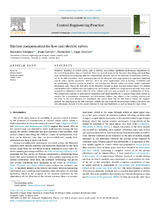Stiction compensation for low-cost electric valves
Autor
Vázquez, Francisco
Garrido, J.
Ruz, Mario L.
Jiménez, Jorge E.
Editor
ElsevierFecha
2023Materia
Process controlNonlinear control
Control valves
Stiction
METS:
Mostrar el registro METSPREMIS:
Mostrar el registro PREMISMetadatos
Mostrar el registro completo del ítemResumen
Nonlinear dynamics of control valves, such as stiction, can produce significant performance degradation in the control loops where they are involved. There are several works in the literature describing and modelling these phenomena and proposing different compensation methods, such as the inclusion of dead-band, knockers, etc. in the PID controllers. These previous studies in the literature have only focused on expensive industrial control valves, mainly pneumatic. However, there are other applications, such as heating, ventilation and air conditioning (HVAC) systems in vehicles, that use low-cost electric valves and where similar undesired phenomena arise. This is the first work in the literature focused on these low-cost control valves. We studied and modelled their nonlinearities and analysed the performance of different compensation methods, both those proposed for industrial control valves by other authors and new ones proposed as a combination of them. This comparative analysis is performed in simulation and experimentally for a control temperature system in coaches. For a quantitative comparison, two performance indices, one related to the tracking setpoint and the other to the valve lifespan, are considered. The results show that for this kind of valves, the simplest method, the dead-band in the PID controller, obtains the best trade-off between these indices and shows the best advantages because it is the easiest solution to tune and implement as well as being the most robust.

